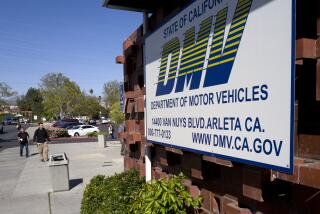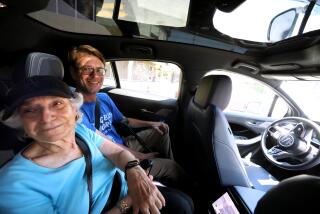When First-Time Drivers Get a Grip on Wheel of Life
- Share via
Today is Madeline Leavitt’s first day of driving school.
In her 44 years, she’s been behind the wheel of a car once, two or three years ago, when her husband tried to teach her to drive in a parking lot.
“This is the last holdout (keeping me) from independence,” she says. “I feel like a teen-ager when I have to call and ask my friends, ‘Can I have a ride to dance class?’ I walk everywhere now, to the grocery store, to school, but if there was an emergency at my kids’ schools, what would I do?”
She pauses and smiles nervously.
“I’m really trying to talk myself into this, can you tell?”
The instructor’s supposed to arrive soon; the seconds are ticking off like a deadline to destiny.
“People are amazed when I tell them I don’t drive,” she says between gulps of water. “They feel like I should get some kind of an award. I think I’m more embarrassed by it.”
She looks out the living room window anxiously.
“I think he’s here.”
For the five years she’s lived in L. A., Leavitt has gotten by without a car. But the former New Yorker, a drama consultant at a nearby school, has found it increasingly difficult to rely on others for rides. “A friend of mine who also didn’t drive and then took lessons said, ‘C’mon, get Mr. Torres, he’s really good. You can do it.’ She’s been encouraging me for two years to make this phone call.”
In L. A., people like Leavitt who reach adulthood without learning how to drive often keep their secret hidden, afraid they’ll be branded as different , strange , and maybe even phobic . So today she’s conquering one of her biggest fears. And she’s not alone.
Sylvia Moore doesn’t look nervous.
She is waiting for the man from California Driving School in the living room of her parents’ Crenshaw-area house. Moore, a 21-year-old senior at UC Berkeley, says that in high school her parents weren’t crazy about the idea of her driving--for safety reasons--and she always managed to get around by bus, or with friends and family. It was never a source of embarrassment, since several friends didn’t drive either. And in Berkeley, public transportation is all she needs.
“But I want to go to law school next year at UCLA,” she says, “and I want to be able to drive if I’m going to be living here.”
Instructor Elias Cooper drives the Moores’ car to a quiet neighborhood and they switch places.
She’s hesitant at first, but shifts smoothly into drive, releases the brake and the car moves.
“OK, give it a little gas,” Cooper says, and the car lurches forward as Moore gets a feel for the 3,000-pound machine of chrome, fiberglass and vinyl.
They come to a stop sign behind another automobile and Cooper tells her that it’s best not to stop with only a few inches between bumpers. “Make sure you can see the fender a little bit of the road,” he says. “That can prevent being rear-ended in a chain collision. If you do that, you’ll be the only one in California who does.”
They continue practicing turns, Moore trying the hand-over-hand method.
Cooper tries to reposition Moore’s hands, then stops.
“Now, I’m pretty strong,” he says, “but I can’t even pry your hands off of this wheel. If you take your hands off the wheel for a second, nothing drastic is going to happen, so you don’t have to have a death grip.”
Moore laughs and finally relaxes. “You’re doing fantastic!” he says.
In a quiet residential area of Santa Monica, Leavitt sits behind the wheel of the special dual-control car. The “STUDENT DRIVER” sign looms on the roof. Terror is giving way to excitement.
Jack Torres of the Sears Driving School has given her a written exam and a vision test and issued her a student permit. From the passenger side he demonstrates the correct hand position (at 10 o’clock and 2 o’clock, hold the wheel lightly, thumbs hanging down, relaxed). He tells her to put her foot on the brake.
“I can’t remember which is which,” she says. He helps her. She recalls the last time she tried this she nearly choked under the strain of information overload.
“This is going to be an analysis lesson,” he goes on, “to look at your analysis and judgment of certain situations. I won’t be giving you a lot of instruction, just so I can see how much you know, then I’ll tell you how long it’ll take you to learn how to drive, based on what I observe. You’ll just be using the gas pedal, I’ll be braking for you.”
She is rocky at first, not knowing how to start the car or shift the automatic into drive.
“Which way do I look to see if someone’s coming?” she asks as she makes a left turn. “Whoa . . . am I doing this right? Whoa. I feel so close to the curb.”
“That’s because you are,” Torres says, his voice soothing and calm as he takes the wheel and gently steers the car away.
Gradually Leavitt gains more confidence as she realizes she is actually driving a car .
“This feels nice!” she says enthusiastically.
“I’m glad to hear that,” Torres says.
“I couldn’t sleep last night,” Halipah Wulff says, giggling with nervous energy. She adjusts herself on the booster seat of the Sears Driving School Car. Her instructor, Claudia Tucker, tells her to step on the brake and Wulff does, only with her left foot.
“We only use the right foot when we drive,” Tucker says.
Nonetheless, as the lesson progresses Tucker is pleased with Wulff’s natural abilities. The petite 39-year-old from Malaysia has driven a motorcycle, but never a car. She’s been bicycling to and from school and work, but she doesn’t feel safe being out after dark around her Santa Monica/Venice neighborhood. Her husband, an attorney, promised that after her birthday she could learn to drive.
Wulff practices turn after turn, repeating her hand positions like a mantra: “Push, pull, push, pull, hold, gas.”
Tucker looks over and says, “If you keep dropping your hands too low on the wheel we’re going to have to get you some glue!” Wulff giggles and says in mock seriousness, “Ohhhh, I am baaad driver!”
After about 20 times around the same corners, Tucker directs her back home, and Wulff suddenly finds herself driving in traffic. With her teacher’s help she is able to make it, even accomplishing a U-turn and parking.
She sets the emergency brake, lets out a huge sigh and says, “Oh, thank you God, I am safe.”
After six more lessons, Madeline Leavitt has learned this about most other drivers: “People are not courteous on the road,” she says emphatically. “And they don’t obey traffic rules. Pedestrians don’t look when they’re crossing. And sometimes people honk at me, even though I’m in a car with the ‘student driver’ sign on top. Some people have been patient, though.”
No doubt those are the ones who remember the first day of driving school all too well.






